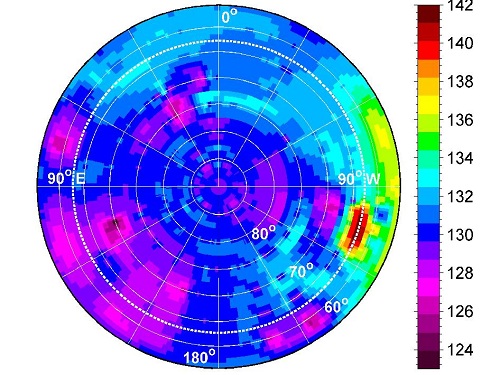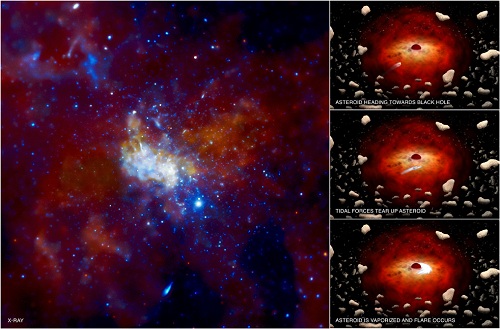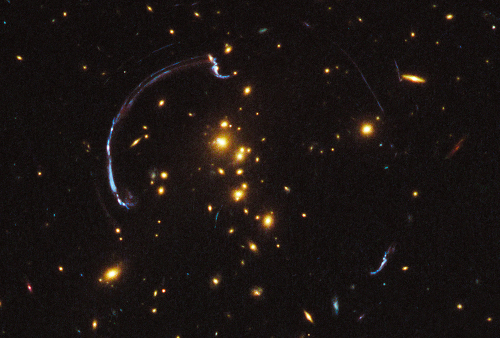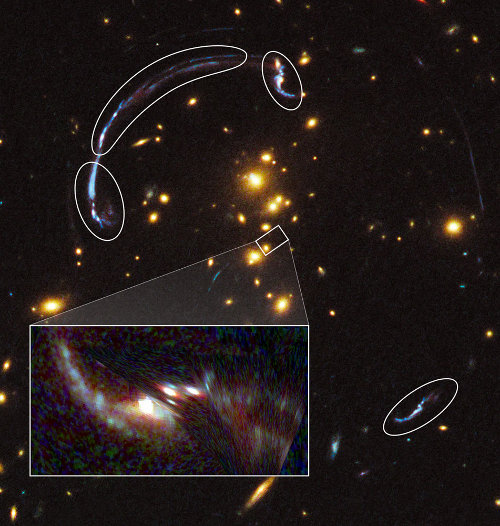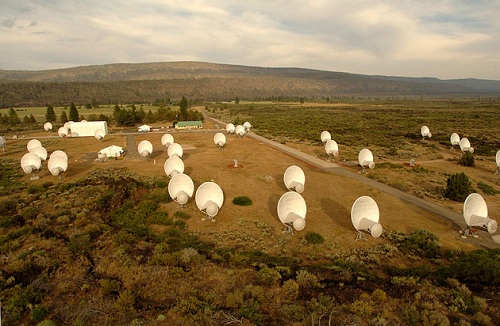Centauri Dreams
Imagining and Planning Interstellar Exploration
Of Ice and the Planetesimal
Mindful of the recent work on axial tilt I’ve reported in these pages, I was interested to learn that Vesta’s axial tilt is just a bit greater than the Earth’s, about 27 degrees. We’ve been pondering the consequences of such obliquity on planets in the habitable zone, but in Vesta’s case, the issue isn’t habitability but water ice. For spurred by the Dawn mission, scientists are looking at whether permanently shadowed craters on the asteroid’s surface would allow water to stay frozen all year long. Unlike the situation on the Moon, the answer on Vesta (on the surface at least) seems to be no.
Earth’s axial tilt is 23.5 degrees, but the Moon’s is a scant 1.5 degrees, making the shadow in some lunar craters permanent, a fact that has led to speculation that ice in these locations could be of use to future manned missions there. In contrast, Vesta’s obliquity means that it has seasons, so that every part of the surface becomes exposed to sunlight at some point in the year. Even so, says Timothy Stubbs (NASA GSFC), “Near the north and south poles, the conditions appear to be favorable for water ice to exist beneath the surface” [italics mine].
Image: New modeling shows that, under present conditions, Vesta’s polar regions are cold enough (less than about 145 K) to sustain water ice for billions of years, as this map of average surface temperature around the asteroid’s south pole indicates. (The white dashed line marks Vesta’s south polar circle.) Figure reprinted from the paper in Icarus by T.J. Stubbs, T.J. and Y. Wang. Image credit: NASA/GSFC/UMBC.
The polar regions on Vesta are under scrutiny as the Dawn mission continues its close look. Observations from the Earth have suggested a bone-dry Vesta, but in its current low orbit, Dawn is using its gamma ray and neutron detector (GRaND) spectrometer to look for hydrogen-rich deposits that might flag the presence of water ice below the surface. Because Dawn’s targets — Vesta and Ceres — are both considered remnant protoplanets, it will be important to learn whether there is sub-surface water on Vesta. The next issue to ponder will be whether any water that is discovered has arrived recently or goes back to the earliest days of the Solar System.
Modeling has shown that water ice should be able to survive in the top few meters of regolith when surface temperatures are less than 145 K or so, and while Vesta’s equator sees average yearly temperatures around 150 K — too warm to sustain water ice within meters of the surface — the regions near the asteroid’s north and south poles are cold enough to allow its survival for billions of years. The temperature dividing lines show up at about 27 degrees north latitude and 27 degrees south latitude.
As for the surface, this JPL news release quotes Stubbs on the matter:
“The bottoms of some craters could be cold enough on average — about 100 kelvins — for water to be able to survive on the surface for much of the Vestan year [about 3.6 years on Earth]. Although, at some point during the summer, enough sunlight would shine in to make the water leave the surface and either be lost or perhaps redeposit somewhere else.”
Ceres, the second of Dawn’s destinations, should prove a study in contrasts. As compared with Vesta’s dry surface, Ceres may have seasonal polar caps of water frost and even a thin atmosphere. Some models show a layer of 100 kilometers of icy material including water and ammonia, and allow the presence of liquid water beneath. Recall that this is the most massive body in the main asteroid belt, making up perhaps as much as a third of the mass of the entire main belt. Hubble observations have suggested that the topography here is low, with a lack of deep craters that indicates flow in the crust to even out the landscape. Dawn will be able to give us better estimates of Ceres’ mass and help us understand how that mass is distributed.
The paper on Vesta is Stubbs and Wang, “Illumination conditions at the Asteroid 4 Vesta: Implications for the presence of water ice,” Icarus Vol. 217, Issue 1, pp. 272-276 (January, 2012).

A ‘Super-Oort’ Cloud at Galactic Center?
Not long ago we looked at comet C/2011 N3 (SOHO), discovered last July just two days before it plunged into the Sun, evaporating some 100,000 kilometers above the solar surface. It was startling to learn that the SOHO observatory is tracking numerous ‘Sun-grazers,’ comets whose fatal encounters with our star are occurring roughly once every three days. Now comes news that Sagittarius A*, the supermassive black hole at the center of the Milky Way, is producing X-ray flares about once a day, thought by some to be the result of similar debris in the process of destruction.
The flares last just a few hours, according to researchers working with data from the Chandra X-Ray Observatory, and can reach brightness levels up to 100 times what is normally observed in the black hole region. Kastytis Zubovas (University of Leicester) thinks we’re seeing asteroids and comets passing within 160 million kilometers of the black hole (roughly 1 AU), at which point they would likely be broken apart by tidal forces and eventually vaporized as they move through the hot, thin gas surrounding and feeding Sgr A*.
“As a reality check, we worked out that a few trillion asteroids should have been removed by the black hole over the 10-billion-year lifetime of the galaxy,” said co-author Sera Markoff of the University of Amsterdam in the Netherlands. “Only a small fraction of the total would have been consumed, so the supply of asteroids would hardly be depleted.”
Image (click to enlarge): The panel on the left is an image containing nearly a million seconds of Chandra observing of the region around the black hole, with red representing low-energy X-rays, green as medium-energy X-rays, and blue being the highest. An asteroid that undergoes a close encounter with another object, such as a star or planet, can be thrown into an orbit headed towards Sgr A*, as seen in a series of artist’s illustrations beginning with the top-right panel. If the asteroid passes within about 100 million miles of the black hole, roughly the distance between the Earth and the Sun, it would be torn into pieces by the tidal forces from the black hole (middle-right panel). These fragments would then be vaporized by friction as they pass through the hot, thin gas flowing onto Sgr A*, similar to a meteor heating up and glowing as it falls through Earth’s atmosphere. A flare is produced (bottom-right panel) and eventually the remains of the asteroid are swallowed by the black hole. Credit: X-ray: NASA/CXC/MIT/F. Baganoff et al.; Illustrations: NASA/CXC/M.Weiss.
To generate flares large enough for Chandra to see, the objects in question would have to be roughly 10 kilometers in radius or larger. These are relatively small events compared to what might happen when an entire star passed too close to a supermassive black hole, which would power a spectacularly bright flare of the kind that has been observed in other galaxies. But disintegrating stars are thought to be rare, while the Chandra flares are common, and last only hours compared to the larger events, which can be studied for a period of months.
Zubovas and team have developed a model that looks at the asteroid population passing near Sagittarius A*, one that offers criteria for testing whether a given flare is the result of an external object encountering the black hole or the result of instabilities within the accretion disk already around it. From the paper:
The least constrained parts of the model have to do with the exact distribution of asteroids and their orbits in the hypothesised ”Super-Oort cloud” around Sgr A* and with conversion of the bulk kinetic energy of the asteroids into electromagnetic radiation. However, there almost certainly are asteroids in the central few pc of the Galaxy and the processes described here must occur. Our paper makes several estimates of the e?ects that asteroids have on the luminosity of Sgr A* and suggests a method to distinguish between such externally caused ?ares and accretion-instability caused ones. If future observations reveal that asteroid disruptions are responsible for at least a fraction of the ?ares, this would be an important step in understanding the accretion processes in Sgr A*. In addition, further investigation may help constrain the size of the asteroid population in the Galactic centre.
So we’re looking at what can be called a ‘Super-Oort’ cloud, a thick torus of asteroids stripped from their parent stars that surrounds our galaxy’s supermassive black hole. Interestingly enough, the Chandra data fall in line with earlier work suggesting that this cloud of asteroids and planets may have formed through star formation episodes inside the massive accretion disk itself, during phases when the black hole grew rapidly. The asteroids would be drawn from this cloud of stars whenever one of the stars passed too close to the black hole. Where Zubovas’ team differs from some earlier theorists is in seeing the Chandra flares as the result of asteroid interactions with the black hole rather than stars, the latter being of insufficient density to produce the small and frequent flares we see happening in the region of Sgr A*.
The paper is Zubovas et al., “Sgr A* flares: tidal disruption of asteroids and planets?” accepted for publication in Monthly Notices of the Royal Astronomical Society (preprint).

Two Takes on Extraterrestrial Life
“With exoplanets we are entering new territory,” says René Heller (Leibniz Institute for Astrophysics, Potsdam), talking about recent studies looking at axial tilt as a parameter for habitability on a planet. Heller is getting at the fact that while we’ve studied the axis of a planet’s spin relative to the plane of its orbit rather thoroughly here in our own Solar System, we are a long way from being able to discern the axial tilt of exoplanets, much less make definitive statements about its effect on habitability. Right now we can say something about the size, mass and orbital period of many distant planets (and in a few cases, some of the components of their atmosphere) and that’s about where our knowledge stops.
Heller imagines the Earth with an axial tilt something akin to that of Uranus, whose equator and ring system run almost perpendicular to the plane of its orbit. Introduce such high obliquity to the Earth and the north pole would point at the Sun for a quarter of the year and in the opposite direction for another three months. As the year progresses, one pole is scorched while the other freezes, and then the situation reverses. As Heller told Astrobiology Magazine in a recent story, “The hemispheres are cyclically sterilized, either by too strong irradiation or by freezing.”
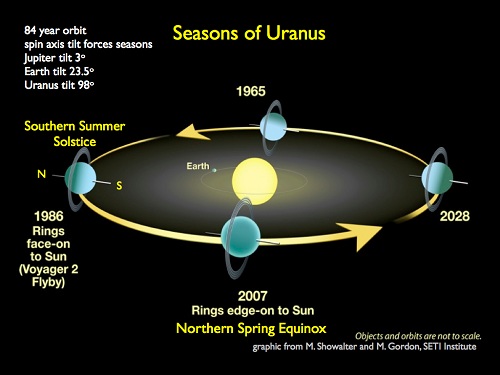
In the same article, George Williams (University of Adelaide) speculates that an axial tilt of as little as 40 degrees would provide a tough environment for complex animals because of the exceedingly hot summers and cold winters that would prevail over much of the globe. He points to evidence for high obliquity in the early Earth, arguing that it may have been a change in axial tilt to something closer to today’s 23.5 degree obliquity that prompted the explosion of lifeforms in the Cambrian era some 540 million years ago. Glacier studies may be giving us some evidence for high obliquity throughout much of Earth’s early history, though what would have altered our planet’s tilt roughly 550 to 600 million years ago to make all this happen remains a mystery.
Plants on the Early Earth
Exoplanets raise so many questions about our own planet’s past, and the obliquity issue is but one factor in all this. We can also home in on the question of plant life, examined in a recent Scientific American blog entry with the assertive title Thanks to Plants, We Will Never Find a Planet Like Earth. The story looks at an open question — how was the surface of the early Earth shaped, particularly by the waters that weathered bare rock to create the soil plants needed to thrive? Martin Gibling (Dalhousie University, Nova Scotia) and Neil Davies (University of Ghent) have analyzed sediment deposition back hundreds of millions of years.
The evolution of vascular plants with complex root systems around 450 million years ago was a major factor in drawing carbon dioxide out of the atmosphere, but Gibling and Davies think these plants were also critical in breaking down rock to form the minerals and mud that helped river banks to form. I went to their paper in Nature Geoscience to look at their views on the interplay between organisms and their physical environments (the growing discipline is called biogeomorphology). The researchers identify a series of changes in Palaeozoic fluvial systems forced by plant evolution, including the introduction of stable muddy floodplains well suited for vegetation and soil development.
The authors see plants acting as ‘geomorphic engineers,’ creating a framework for the complexity of further life:
…the development of meandering rivers with strengthened banks through the Late Silurian and Devonian promoted stable muddy floodplains partially protected by levees and highly suitable for vegetation growth and soil development, including carbonate-rich soils… Early Pennsylvanian suites of narrow fixed channels on muddy plains and of island-braided styles in sand-bed rivers imply an increased length of channel margins and riparian corridors with their varied plant communities and subsurface water prisms, which are of crucial importance for many animal species. The Devonian to Pennsylvanian development of avulsive channel systems generated abandoned channels suitable for organic occupation, especially during dry periods. Towards the sea, concomitant expansion of muddy coastal plains and deltas would have also had many biological consequences. Feedback loops are likely to have been complex.
And so on. Just how valuable was this interplay between plants and the physical environment? This entire issue of Nature Geoscience is devoted to the question, noting how many of Earth’s environmental features were brought about by the evolution of life. The effect of plants goes beyond geochemistry and extends deeply into the landscape, controlling the stability of river banks. Before plant life was ubiquitous, water flowed in broad sheets with few clearly defined channels and floodplains. The editors of the journal think this has implications for exoplanet life:
Even if there are a number of planets that could support tectonics, running water and the chemical cycles that are essential for life as we know it, it seems unlikely that any of them would look like Earth. Even if evolution follows a predictable path, filling all available niches in a reproducible and consistent way, the niches on any Earth analogue could be different if the composition of its surface and atmosphere are not identical to those of Earth. And if evolution is random, the differences would be expected to be even larger. Either way, a glimpse of the surface of an exoplanet — if we ever get one — may give us a whole new perspective on biogeochemical cycling and geomorphology.
Let’s hope that we are indeed able to get that glimpse, and a glimpse at many of the exoplanets being discovered today, particularly those in their star’s habitable zone. It’s hard to argue with the belief that evolution will take a wild variety of courses depending on initial conditions ranging from planetary atmospheres to, as we saw above, axial tilt. What we have ahead of us stretching far into the forseeable future is the chance to begin cataloguing exoplanet ecosystems that we’ll learn more about from spectroscopy and eventual imaging as we tune up our tools. We’ve already learned how wildly one planetary system can differ from another. We can only imagine the extensive range life will take, assuming it’s out there, as it fills each unique niche.
The paper is Gibling and Davies, “Palaeozoic landscapes shaped by plant evolution,” Nature Geoscience 5, 99-105 (2012), published online 01 February 2012. Thanks to my friend Antonio Tavani for the heads-up on this paper and the related story from Scientific American.

Untangling a Lensed Galaxy
Gravitational lensing always gets my attention not only because of its growing use in astronomy but because of its potential for deep space missions like FOCAL, Claudio Maccone’s concept for a deep space probe that would be sent beyond the Sun’s 550 AU gravitational lensing distance to make observations of astronomical targets. FOCAL is an interstellar precursor mission that could give us detailed information about any system to which we might send a future probe. And, as Maccone has shown, lensing could also be used to create the kind of robust communications relay that would function with little data loss over huge distances.
But we don’t have to wait for FOCAL to exploit the potential of lensing for studying distant exoplanets. As Centauri Dreams readers know, gravitational microlensing has developed into a potent tool. A foreground star distorts the light from a background object when the alignment is right, and that magnification is likewise affected by planets orbiting the foreground star. Given the right configuration of star and background object, microlensing can be used to discover planets in a wide range of sizes and distances from their stars. Yes, it does depend on chance alignments, but the same can be said for the transit methods of Kepler.
In exoplanet work, we’re interested in the foreground star and its planets, but on a galactic scale, it’s often the more distant object that provides the scientific windfall. As the image below reminds us, gravitational lensing can be caused by any massive foreground object — from a star to an entire galactic cluster — moving in front of a more distant background object. Here the light from a distant galaxy is magnified and distorted by the effect of a foreground galactic cluster. We’re looking at a Hubble image of the cluster RCS2 032727-132623. Arcing around it almost 90 degrees is the light from a background galaxy that would otherwise be too faint to be studied in any detail.
Image: In this image the light from a distant galaxy, nearly 10 billion light-years away, has been warped into a nearly 90-degree arc of light in the galaxy cluster RCS2 032727-132623. The galaxy cluster lies 5 billion light-years away. The background galaxy’s image is over three times brighter than typically lensed galaxies. The natural-color image was taken in March 2011 with the Hubble Space Telescope’s Wide Field Camera 3. Credit: NASA, ESA, J. Rigby (NASA Goddard Space Flight Center), K. Sharon (Kavli Institute for Cosmological Physics, University of Chicago), and M. Gladders and E. Wuyts (University of Chicago).
What lensing delivers is the chance to study a galaxy that was in a process of intense star formation at a time when the universe was only a third of its present age. Researchers are calling this the brightest ‘magnified’ galaxy ever discovered. You can see from the image that interpreting the distorted light is an art in itself, but it’s one we’re learning as we use lensing to study star formation in galaxies that would otherwise be beyond the range of Hubble’s vision. In this case, the galaxy’s distorted image actually repeats several times, so that interpreting the results becomes a matter of straightening out and reconfiguring this arc of information.
Take a look at the image again, this time enhanced to highlight the arc and display the position of the background galaxy if it were directly visible. Note the reconstructed galaxy at bottom left:
Image: A reconstruction (at lower left) of the brightest galaxy whose image has been distorted by the gravity of a distant galaxy cluster. The small rectangle in the center shows the location of the background galaxy on the sky if the intervening galaxy cluster were not there. The rounded outlines show distinct, distorted images of the background galaxy resulting from lensing by the mass in the cluster. The image at lower left is a reconstruction of what the lensed galaxy would look like in the absence of the cluster, based on a model of the cluster’s mass distribution derived from studying the distorted galaxy images. Credit: NASA, ESA, and Z. Levay (STScI).
The paper on this work notes that the source galaxy is actually lensed into five images, but they are by no means complete copies of each other. Imagine the job in straightening this out:
Due to the location of the galaxy in the source plane with respect to the lensing caustics, parts of the source are multiply-imaged five times, while other parts are multiply-imaged only three times in a merging-pair configuration. In particular, we find that the brightest parts of the giant arc, which were targeted for rest-frame optical spectroscopy by R11, are lensed images of a small region of the source galaxy (~ 10% of the spatial size of the galaxy).
Using imaging data from Hubble’s Wide Field Camera 3, the researchers were able to construct the lens model needed to extract a ‘de-lensed’ image of the background galaxy. In future work, Keren Sharon (University of Chicago) and colleagues intend to map the spectral energy distribution and star formation rate in this galaxy, using further spectroscopy to tighten up their model. The paper is Sharon et al., “Source Plane Reconstruction of the Bright Lensed Galaxy RCSGA 032727-132609,” in press at the Astrophysical Journal (preprint).

Targeting Primitive Asteroids
I see that there is a symposium on the MarcoPolo-R mission coming up in late March, which reminds me that at a time when asteroid missions are increasingly in the news, I have yet to cover this one. It was about a year ago that the European Space Agency selected MarcoPolo-R as one of four candidates for a medium-class mission that would launch between 2020 and 2024. The selection doesn’t mean the mission has been finalized by any means, only that the four missions chosen will undergo a down-selection process to choose the one to implement.
Thus this mission to return a sample of material from a near-Earth asteroid for analysis in ground laboratories will have to prove itself against some formidable competition, including another particularly interesting concept called the Exoplanet Characterisation Observatory (EChO), which would orbit around the L2 Lagrange point and study exoplanet atmospheres. Exoplanets are obviously hot property right now, but asteroids are also having their moment in the Sun, with the decision by the Japanese space agency (JAXA) to collect samples from asteroid 1999 JU3, and NASA’s OSIRIS-REx mission to asteroid 1999 RQ36 slated for a 2016 launch.
MarcoPolo-R fits in well with the OSIRIS-REx mission because both target primitive asteroids, meaning asteroids with low albedo that are thought to be composed of the most ancient materials in the asteroid family. Both the Hayabusa mission to Itokawa and NEAR’s mission to Eros targeted asteroids belonging to the more evolved S class of asteroids. Primitive asteroids are thought to contain organic materials, their dark surfaces possibly laden with carbon-rich material that no process of planet formation has altered. The one primitive asteroid we’ve thus far had a close look at is Mathilde, which reflects only three percent of the Sun’s light.
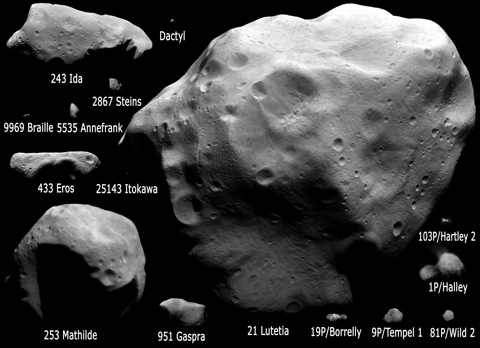
Image: All the images collected by space missions during fly-bys or dedicated visits to asteroids and comets. Regarding asteroids, only the 50 km-size Mathilde has a spectral type and albedo (0.03) consistent with primitive material. However, its size (and therefore gravity) is much higher than that expected for the kilometer-size target of MarcoPolo-R. Credit: ESA.
Is it possible that asteroids like these delivered prebiotic material to the early Earth? Getting the opportunity to study asteroid organics in the laboratory would give us insight into the question. OSIRIS-REx (Origins, Spectral Interpretation, Resource Identification, Security-Regolith Explorer) is also a sample return mission, with return to Earth slated for 2023 after the spacecraft has spent more than a year orbiting 1999 RQ36. Both these missions will offer us further knowledge about the overall composition of near-Earth asteroids, useful information in the event that we ever need to nudge such an object out of a potentially threatening trajectory.
The new Japanese mission, meanwhile, targets asteroid 1999 JU3, likewise interesting from the standpoint of raw materials and an object thought to have come from the main belt between Mars and Jupiter. Humberto Campins (University of Central Florida) is a member of both the Marco Polo-R and OSIRIS-REx teams, as well as an expert on 1999 JU3, about which he says:
“Based on our analysis, it should be rich in primitive materials, specifically organic molecules and hydrated minerals from the early days of our solar system. If successful it could give us clues about the birth of water and life in our world.”
The baseline target for MarcoPolo-R is the binary asteroid (175706) 1996FG3, although several other primitive asteroids with launch windows consistent with the mission have been identified. In addition to learning about the nature of organics in primitive asteroids and their possible role in life’s development, we’ll also have a window into the processes occurring in the early Solar System that led to planet formation, and learn whether near-Earth asteroids contain pre-solar materials that have not as yet turned up in meteoritic samples. The synergy between the three missions is obvious as the MarcoPolo-R symposium approaches on the 26th of March.

SETI in the News
Let me draw your attention to two interesting stories this morning, one harking back to the night in August of 1977 when the Big Ear radio telescope at Ohio State University recorded the famous ‘Wow!’ signal. For those unfamiliar with it, the ‘Wow!’ signal gets its name from Big Ear volunteer Jerry Ehman’s annotation (several days later) on the signal’s printout. ‘Wow!’ seemed appropriate for a signal that was 30 times stronger in volume than the background noise and took up a single 10 kilohertz-wide band on the receiver, an enigmatic 70-second narrow-band burst at almost precisely 1420 megahertz, the emission frequency of hydrogen.
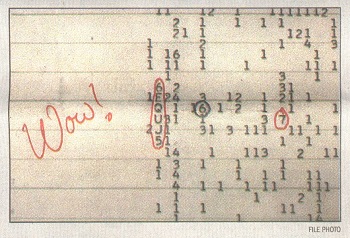
A message from an extraterrestrial civilization? ‘Wow!’ seemed to fit the bill, but it disappeared and despite more than 50 repeated searches by the Big Ear team, it never recurred. In this article for The Planetary Society, Amir Alexander calls the signal “…the single most intriguing result ever produced by the Search for Extraterrestrial Intelligence,” one made all the more frustrating because of the lack of any follow-up signal. Alexander’s story alerted me to the fact that Bob Gray, a data analyst with a passion for radio astronomy, has just published a book on the ‘Wow!’ signal based on three decades of study and observation using a wide variety of equipment.
Image: A 70-second burst that came to be known as the ‘Wow!’ signal. Credit: Columbus Dispatch.
The Elusive Wow: Searching for Extraterrestrial Intelligence (Chicago: Palmer Square Press, 2011) caught my eye not only because of ‘Wow!’ but also because of my love of travel books — Gray’s journeys in support of his SETI research have been globe-spanning. Having built a radio telescope of his own using a 12-foot dish and a steerable mount from a World War II radar installation, he began by operating his own SETI program for fifteen years, looking at the region of the spectrum and the specific coordinates where ‘Wow!’ had first appeared. Then he started expanding the hunt, traveling to the Oak Ridge Observatory near Harvard, Massachusetts.
Alexander’s article tells the tale and I won’t do anything more than hit the highlights here, but suffice it to say that Gray worked with Paul Horowitz at the observatory using a 25-meter radio telescope running META (Million Channel Extraterrestrial Array). He later went to the Very Large Array in New Mexico, whose 27 dishes mounted on rails were put at his disposal for a four hour stretch in September of 1995 (this followed a lengthy proposal submission process). Still later, he wound up in Tasmania at the Mount Pleasant Observatory, working with Simon Ellingsen.
The result: No trace of the ‘Wow!’ signal despite the presence of unknown (and presumably natural) radio sources close to where it had originated. ‘Wow!’ remains a mystery and Gray’s book will keep its tantalizing story alive as he continues his personal quest to nail it down. Alexander quotes him as calling ‘Wow!’ ” “…a pretty strong tug on the cosmic fishing line,” about as charming an image as can be imagined for this most intriguing of all SETI results to date. Gray’s book is in my reading stack and I’ll be offering my own review in the near future.
Money and Commitment at the ATA
The 42 radio telescopes of the Allen Telescope Array, located near Lassen Peak in Hat Creek, California, are one day to be joined by more than 300 more if the original plan is followed, but at the moment the installation’s financial problems are what occupies its supporters even as they continue their observations. New York Times science writer Dennis Overbye tells the tale in a late January story that looks at the ATA and its possibilities, examining what he calls “…a dream deferred by politics, a lack of money and the technological challenges of searching what astronomers call ‘the cosmic haystack’: 100 billion stars in the galaxy and 9 billion narrow-band radio channels on which aliens, if they exist, might be trying to hail us.”
Image: The Allen Telescope Array continues its work as funding issues are temporarily resolved. Credit: ATA.
Centauri Dreams readers will recall that the University of California’s own funding for the ATA ran out last spring, sending the telescopes into forced hibernation until a funding appeal sent out over the SETI Institute’s Web site brought in enough money to fund about two more months of operations. The US Air Force is also interested in the array’s possibilities in terms of tracking satellites and space debris, an agreement that is still being negotiated. The ATA is back in business (since December), but the financial shortfalls ahead are sizable for an installation that needs $1.5 million per year for operations and another $1 million for the staff of astronomers.
Microsoft founder Paul Allen ponied up $25 million to launch the original project, which would be owned by the University of California at Berkeley as well as the SETI Institute, but fleshing out the remaining 300 or so antennas will require a cool $55 million, making the ATA a site in search of philanthropists. As Overbye recounts, SETI has never been robustly funded and has been controversial from the start, particularly with alarming price estimates like the $10 billion a 1971 NASA workshop came up with for a giant telescope array that would have been called Cyclops. The infamous 1978 ‘Golden Fleece’ award from Wisconsin senator William Proxmire only added to the problems, leading to the cancellation (in 1993) of NASA’s SETI survey work.
Taking SETI private was the only option, but the tough-minded scientists who continue this work soldier on despite the challenges. Writes Overbye:
Astronomers now know that the galaxy is teeming with at least as many planets — the presumed sites of life — as stars. Advanced life and technology might be rare in the cosmos, said Geoffrey W. Marcy, the Watson and Marilyn Alberts in the Search for Extraterrestrial Intelligence professor at the University of California, Berkeley, “but surely they are out there, because the number of Earthlike planets in the Milky Way galaxy is simply too great.”
A simple “howdy,” a squeal or squawk, or an incomprehensible stream of numbers captured by one of the antennas here at the University of California’s Hat Creek Radio Observatory would be enough to end our cosmic loneliness and change history, not to mention science. It would answer one of the most profound questions humans ask: Are we alone in the universe?
I like the way Overbye frames this story, highlighting a band of astronomers depending on “…the stubborn strength of their own dreams,” a description which goes a long way toward explaining Bob Gray’s own persistent hunt for the ‘Wow!’ signal as well. It takes passion, and a hide as tough as a Texas longhorn’s, to fight through budget shortfalls, political maneuvering and the sheer intractability of the technical problems involved in pulling an intelligent signal out of the cosmos. But things are happening again at Hat Creek and have been since December, while the question of how long the site will stay operational hovers over SETI like an ominous cloud.

